Current Research Areas
Root Trait Ecology, Evolution, and Effects on Soil Carbon
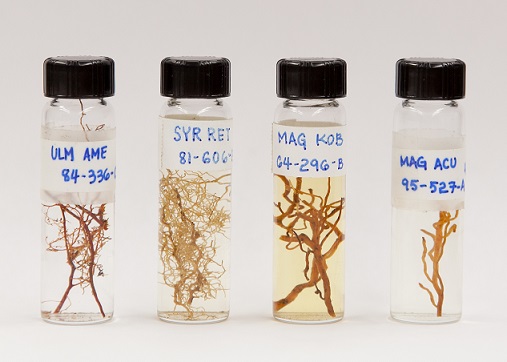
Root biomass and root traits are key drivers of ecosystem processes, and fine root inputs are the major type of plant tissue that contributes to soil organic matter and soil carbon (C) sequestration. However, despite obvious differences between roots and leaves in morphology, chemical composition, and surrounding environments, root decomposition is currently conceptualized in terrestrial ecosystem models almost entirely based on what we know about leaf decomposition. This view is being overturned by a renewed effort to collect root trait data worldwide and make detailed measurements of root decomposition dynamics.
Root biomass and root traits are key drivers of ecosystem processes, and fine root inputs are the major type of plant tissue that contributes to soil organic matter and soil carbon (C) sequestration. However, despite obvious differences between roots and leaves in morphology, chemical composition, and surrounding environments, root decomposition is currently conceptualized in terrestrial ecosystem models almost entirely based on what we know about leaf decomposition. We have found that root traits in temperate regions seem to be strongly constrained by broad evolutionary patterns, with surprisingly little correlation with expected factors of mycorrhizal type, plant growth form, or leaf traits. In addition, mechanisms of root decomposition can differ from the predominant view that plant chemical traits affect decomposition through the activity of decomposer microbes, which has important consequences for stabilization of soil C.

Together, these findings indicate that considering root morphological traits and incorporating biogeographic and phylogenetic distributions of differing plant groups may be a path toward enhancing global C models.
- Lab personnel: Anthony Minerovic, Ashley Sumpter, Oscar Valverde-Barrantes
- Funding: NSF DEB-1549964
- Recent Papers:
- Minerovic, A.J., O.J. Valverde-Barrantes, C.B. Blackwood. 2018. Importance of Physical and Microbial Mechanisms of Decomposition Vary by Root Order in Two Temperate Tree Species with Differing Chemical and Morphological Traits. Soil Biology and Biochemistry 124:142-149.
- Valverde-Barrantes, OJ, GT Freschet, C Roumet, CB Blackwood. 2017. A worldview of root traits: the influence of ancestry, growth form, climate and mycorrhizal association on the functional trait variation of fine root tissues in seed plants. New Phytologist 215: 1562–1573.
- Valverde-Barrantes, O.J., A.L. Horning, K.A. Smemo, C.B. Blackwood. 2016. Phylogenetically structured traits in root systems influence arbuscular mycorrhizal colonization in woody angiosperms. Plant and Soil 404:1-12.
Cascading Effects of Dominant Tree Types in Temperate Hardwood Forests
Adult trees have a profound influence over their environment by dominating nutrient absorption and turnover of root and leaf tissue. One aim of this project is to determine what characteristics of dominant adult trees (e.g., mycorrhizal associations, litter chemistry, evolutionary history) can be used to predict effects on soil biogeochemistry and microbial communities. In addition, we are investigating the cascading effects of the environment created by dominant trees, leading to surrounding plants experiencing greater likelihood of nutrient limitation or negative plant-microbe feedback.
- Lab personnel: Andrew C. Eagar, Jessica Nowjack, Oscar Valverde-Barrantes
- Collaborators: Rich Phillips (Indiana University), Kurt Smemo (Skidmore College)
- Funding: NSF DEB-1834241
Building a Forest: the Forest Soil and Tree Ecosystem Restoration
(FoSTER) Project
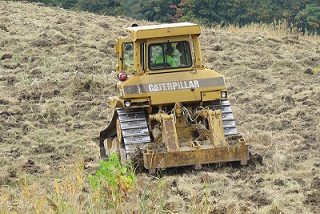 at Cuyahoga Valley National Park
at Cuyahoga Valley National Park
Even after reclamation, many former surface mines host dense thickets of invasive plants and exhibit soil that is compacted and prone to erosion, possibly releasing sediment and nutrients into nearby streams. We are participating in design and monitoring of new restoration efforts at former surface mines in Cuyahoga Valley National Park. The goal is to intervene in the system more directly to accelerate the return of naturally occurring ecosystem structures and dynamics (e.g., native species and biogeochemical and geomorphic processes).
In addition, tree plantings are being designed to establish a long-term, large-scale experiment that will test effects of tree species identity on ecological, geomorphic, and biogeochemical dynamics. This will directly test theories related to the importance of tree mycorrhizal type and phylogenetic clade, and help develop a predictive framework relating tree species to a wide variety of inter-related environmental issues, from restoration success to nutrient runoff to climate change projections.
- Lab personnel: Tom Ruggles
- Collaborators: Chris Davis (Cuyahoga Valley National Park), Anne Jefferson (Kent State University), Christie Bahlai (Kent State University)

Ecology of Green Roofs
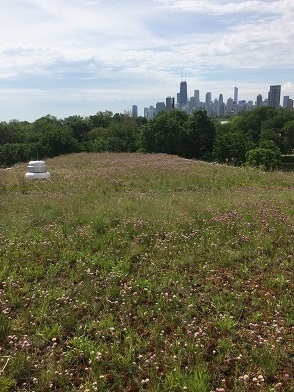
Urban environments are highly managed and have a unique range of stressors for plant, animal, and microbial communities. Green Infrastructure refers to constructed features of an urban environment using plants and soils in order to solve problems and enhance residents connections to the natural world in the urban environment. This typically emphasizes rainwater catchment and management, but can also include lowering temperatures, prolonging roof membrane lifespan, creating habitat for animals, beautifying the area, eliminating air pollutants and reducing the urban heat island effect. Examples of green infrastructure include rain gardens, green roofs and living walls.
In 2014, a team of students from biology, architecture, and geology participated in the EPA P3 competition and created a novel green infrastructure design concept—the Moveable Meadow (patent pending). This portable, modular green infrastructure technology is optimized to capture stormwater and enhance biological diversity, particularly in industrial brownfield sites where stormwater runoff can carry contaminants into the surrounding environment.
One of our current projects involves testing different biological communities in prototypes of the Moveable Meadow, conventional green roof substrate, and a quasi-traditional Swiss style green roof making using local materials. This experiment is taking place at the Cleveland Industrial Innovation Center, an active industrial complex in Cleveland.
We are also conducting a survey of green roofs across a range of Midwest cities (Chicago, Cleveland, and Minneapolis), ages (1-20 years old), and sizes (150-500,000 square feet). We hope to quantify the range of variation in operating green roofs and broaden the scope of green roof research by examining the variations in soil fungi, mesofaunal diversity, and soil organic matter.
- Lab personnel: Anna Droz, Taylor Fulton
- Collaborators: Reid Coffman (Kent State College of Architecture and Environmental Design)
- Funding: EPA P3 Grant #83570001

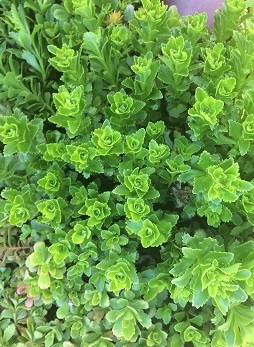

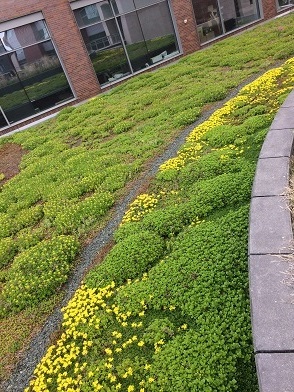
Functional Ecology of Microbial Community Assembly and Decomposition of Senesced Leaves
Saprotrophic fungi are the primary agents of leaf litter decomposition in forest ecosystems, the main determinant of soil fertility and carbon sequestration. Fungal communities develop on millions of senescent leaves each year, providing an ideal opportunity to study how these biotic communities assemble and function. Decomposition of leaves by fungi is regulated by the expression of extracellular enzymes that degrade plant cell wall polymers. Because of the enormous diversity, redundancy, and genomic plasticity present in fungi, it is unclear to what extent variation in microbial taxonomic composition affects leaf decomposition. We are involved in a series of projects examining the relationships among leaf biochemistry, fungal species traits, and processes such as dispersal and priority effects in determining fungal community composition and activity.
- Lab personnel: Matt Gacura
- Collaborators: Don Zak (University of Michigan), Mike Weintraub (University of Toledo)
- Funding: National Science Foundation Grants DEB-0918240 and DEB-0918878
- Recent Papers:
- Feinstein, L.M., C.B. Blackwood. 2013. The spatial scaling of saprotrophic fungal beta diversity in decomposing leaves. Molecular Ecology 22:1171-1184.
- Feinstein, L.M., C.B. Blackwood. 2012. Taxa-area relationship and neutral dynamics influence the diversity of fungal communities on senesced tree leaves. Environmental Microbiology 14:1488-1499.
- Wu, L., L.M. Feinstein, O. Valverde-Barrantes, M.W. Kershner, L.G. Leff, C.B. Blackwood. 2011. Placing the effects of leaf litter diversity on saprotrophic microorganisms in the context of leaf type and habitat. Microbial Ecology 61:399-409.
Living on Edge: Community Assembly in Complex Landscapes and across Ecotones
We are characterizing microbial, plant, and animal communities across a temperate forest (Jennings Woods) with variable hydrology and soils. To test hypotheses about how ecological guilds interact on regional and local scales, metacommunity models of community assembly are being compared for multiple ecological guilds across the same environment. We have already found that the correlation between tree communities and soil properties is decoupled near ecotones, and this is being followed up by examining other guilds, functional traits, and consequences for soil biogeochemistry. Molecular methods are being used to determine the functional traits and composition of tree roots and microorganisms.
- Lab personnel:Colleen Cosgrove
- Collaborators: Mark Kershner (Kent State University)
- Recent Papers:
- Blackwood, C.B., K.A. Smemo, M.W. Kershner, L.M. Feinstein, O.J. Valverde-Barrantes. 2013. Decay of ecosystem differences and decoupling of tree community-soil environment relationships at ecotones. Ecological Monographs 83:403-417.